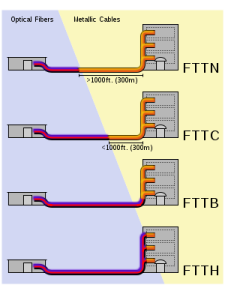Differences Between FTTH, FTTC, and FTTN
FTTH, FTTC and FTTN are fiber optic legs. Made of strands of glass, fiber optic Internet provides faster, smoother service with more room for signal traffic compared to traditional copper cable wires.
FTTH (Fiber to the Home), FTTC (Fiber to the Curb) and FTTN (Fiber to the Node) refer to the wiring path and configuration the signals travel. The closer the fiber optic legs reach to the final destination, the better the connection.
How do FTTH, FTTC and FTTN differ?
FTTC vs FFTB vs FTTH

FTTH (Fiber to the Home) moves between the property line switch box and the residents’ junction boxes. Because the connection goes directly to individual residences, FTTH offers a higher bandwidth. It’s expensive to install in some areas. Some carriers install fiber optics for this leg as a selling feature in new developments. But, a FTTH home has a disadvantage if a carrier needs to install a separate power line. Power and Internet signals don’t move together in fiber optics.
FTTC (Fiber to the Curb) doesn’t refer to a concrete curb. It’s the pole or closet that houses the mounted communications device. Coaxial cables or twisted pairs then send the signals from the curb to the home. However, bandwidth is lost during this delivery. FTTC can serve several customers within 1,000 feet.
FTTN (Fiber to the Node or Neighborhood) serves a few hundred customers. They must be within a one mile radius. The remaining distance to the home, often referred to as the “last mile,” can use DSL through existing telephone or cable company lines. Customer proximity to the node and delivery protocols determine data rates.
While FTTH can offer faster speeds, it is more expensive to install. FTTC or FTTN provides fiber optic Internet to more customers at less expense.
